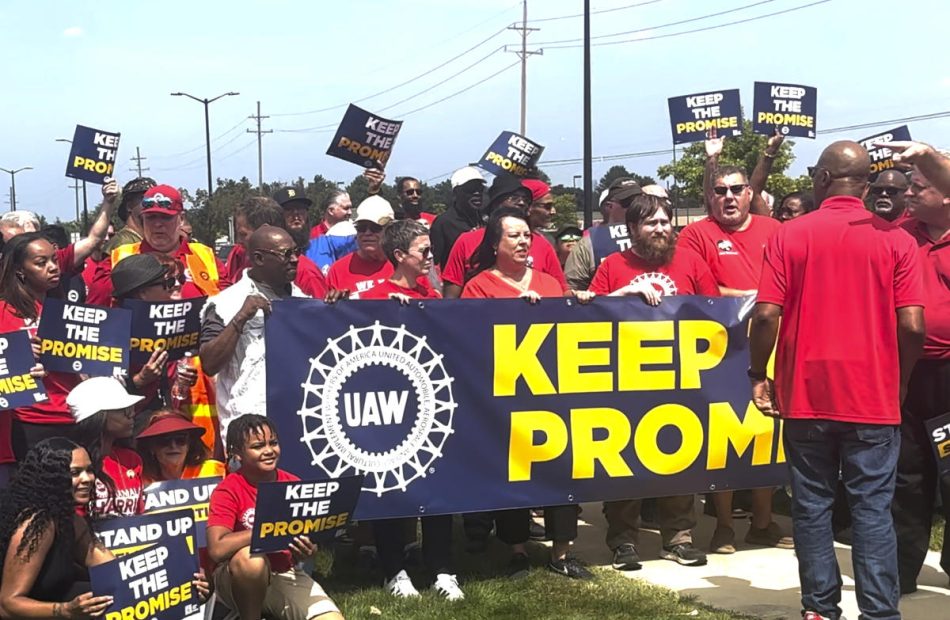UAW's rift with Stellantis raises fear that some US auto jobs could vanish
STERLING HEIGHTS, Mich. (AP) — To Ruth Breeden, who assembles Ram trucks in this Detroit suburb, a simmering dispute between the United Auto Workers and Stellantis isn’t merely about whether her employer will reopen a distant factory in Illinois. To her, the standoff is a danger sign for all UAW workers.
Stellantis had pledged to reopen the factory in Belvidere, Illinois, under a contract it forged last year with the union. But the reopening was delayed given what the company calls unfavorable “market conditions.”
Stellantis says it will eventually reopen the plant. But no date has been given to restart it or open a new battery plant and a parts warehouse, both of which were also promised in the contract that ended the UAW’s strike against Stellantis last year. At stake are over 2,700 jobs.
Breeden and other union members fear that Stellantis will break other commitments, jeopardizing their jobs.
“It’s the whole company,” she said at a union rally last month near her factory. “Who knows which plant is next?”
Union leaders have threatened to strike, a move that could extend beyond Stellantis. Labor experts say its two Detroit-area rivals, Ford and General Motors, are watching as they consider strategies that include whether to move future production out of the U.S.
Detroit automakers have been expanding production in Mexico for years. And after last fall’s strikes shut down a Ford truck plant, its CEO warned the company would rethink where it builds new vehicles.
“There’s plenty of history of the U.S. manufacturing sector moving its operations to low-wage countries,” said Bob Bruno, a labor and employment relations professor at the University of Illinois. “It seems reasonable to me for the UAW to be concerned about not opening here, not investing here.”
In February 2023, the last Jeep Cherokee SUV rolled off the assembly line in Belvidere, about an hour northwest of Chicago, and 1,350 workers were laid off. Stellantis had planned to close the factory.
After six-week strikes against all three Detroit automakers last fall, each company signed a new contract with the UAW. Stellantis agreed to reopen Belvidere Assembly in 2027, with plans to build up to 100,000 electric and gas-powered midsize pickups annually.
It also agreed to open a parts hub in Belvidere this year and an electric-vehicle battery factory with 1,300 workers in 2028. In all, the company pledged $18.9 billion of U.S. investments during the contract, which runs until April 2028.
So promising was the prospect of reopening Belvidere that it drew a celebratory visit from President Joe Biden and a pledge of $335 million in federal dollars to revamp the 5-million-square-foot plant.
A year later, there’s no parts hub and no definitive plan to open the assembly and battery plants, setting off alarms among union members.
On Wednesday, Stellantis said it would spend roughly $400 million to revamp three Michigan factories to build electric vehicles or parts. Breeden’s plant will receive about $235 million of the money, which was included in the contract.
Still, Breeden fears that CEO Carlos Tavares, who talks frequently about cutting costs, wants to move more production to low-wage Mexico, where the company already builds Ram pickups.
“The truth is Stellantis doesn’t want to invest in America,” UAW President Shawn Fain said in a recent video.
Tavares has said that one reason Stellantis needs to slash costs is to make electric vehicles — which cost roughly 40% more to build than gas-powered cars do — affordable to typical customers.
Experts say the Belvidere matter could end up in court.
In August, Stellantis announced that it would stop making older Ram pickups at a plant in Warren, Michigan, and it will lay off up to 2,400 workers. It was the latest sign that Stellantis’ U.S. workers face an uncertain future, said Marick Masters, business professor emeritus at Wayne State University.
Stellantis said it stands by its commitment to Belvidere, but said it needs the delay so it can afford to remain competitive and preserve U.S. factory jobs.
“It is critical that the business case for all investments is aligned with market conditions and our ability to accommodate a wide range of consumer demands,” Stellantis said in a statement.
The company noted language in a letter detailing investments that’s part of the contract. It says Stellantis and the UAW agree that investment and jobs in North America are “contingent upon plant performance, changes in market conditions, and consumer demand continuing to generate sustainable and profitable (sales) volumes.”
Maite Tapia, associate professor at Michigan State University’s School of Human Resources and Labor Relations, noted that language in union contracts is often intended to appease both parties.
The UAW counters that its contract authorizes strikes over plant closures and broken investment promises.
Stellantis, which has been slow to shift to increasingly popular lower-cost vehicles, has struggled this year. Its U.S. sales fell nearly 16% in the first half. Profits tumbled 50%.
Still, overall U.S. new-vehicle sales rose 2.4% through June. The union argues that GM and Ford are doing well and that Stellantis would be, too, if not for Tavares’ poor management.
Fueling angst on assembly lines is a February statement by Ford CEO Jim Farley, who said his company would rethink where it builds vehicles. Farley sounded that warning after the 2023 strikes shut down Ford’s largest and most profitable plant, which makes heavy-duty trucks in Louisville, Kentucky. In July, Ford said it would revamp a factory in Ontario to build the same trucks.
Before last year’s strikes, Farley said, Ford kept making pickups in the United States despite higher labor costs and competitors that build them in Mexico.
Fain scoffed at the notion that Detroit automakers will move production out of the U.S. because of a more aggressive union. He complained that over the past 20 years, automakers have closed or sold 65 factories during a period when the UAW was more cooperative.
“That’s hundreds of thousands of jobs that cost us,” Fain said.
In the meantime, the standoff with Stellantis over Belvidere has led the UAW to threaten to strike in October.
“We expect them to honor the commitment they made,” Fain said. “If they don’t, we put language in this agreement so that we can hold them accountable. And we’re going to.”




Leave a Reply